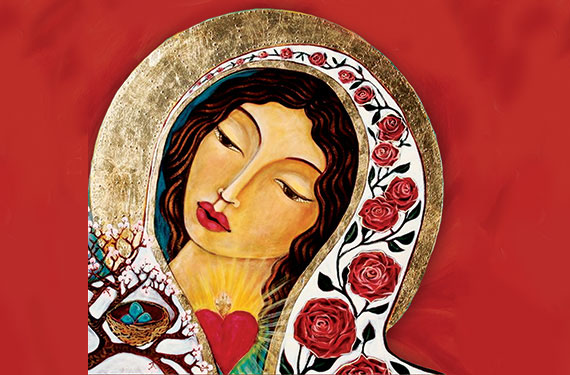Azadi ka Amrit Mahotsav Kolkata event honours four Clergymen
Pope Francis asks businesses to support working women: They’re ‘afraid to get pregnant’
Study: Christianity may lose majority, plurality status in U.S. by 2070
Indian politician declines Magsaysay Award under party pressure
Like John Paul II, Pope Francis heads to Kazakhstan during time of war

After tackling the various missionary crises, it is very fitting that EG emphasizes the role of Mary at the end. True, it is customary for most of papal documents to conclude it by paying tribute to Mary. But it is not simply that kind of customary tribute that is paid in EG. It duly brings out the different roles Mother Mary plays in the Church and finally entrusts the whole missionary work of the Church to the care of Mother Mary.
The first and foremost ground for acknowledging Mary’s role in the Church is that Jesus our Lord has gifted his mother to his people at the crucial moment of his crucifixion. Quoting Blessed Isaac of Stella, the Pope remarks that just as Virgin Mary brought forth Jesus Christ to the world, each of the faithful is also believed to be a bride of God’s word, a Mother of Christ, His daughter and sister, “at once virginal and fruitful.” Yes, “Christ dwelt for nine months in the tabernacle of Mary’s womb. He dwells until the end of the ages in the tabernacle of the Church’s faith. He will dwell forever in the knowledge and love of each faithful soul” (# 285). Thus, there is an obligation on our part to strive after Mary in birthing Christ whenever and wherever possible.
Then the EG devotes a long paragraph to enumeration of the different ways in which Mother Mary plays her role in evangelization (#286). Firstly she “was able to turn a stable into a home for Jesus, with poor swaddling clothes and an abundance of love.” Besides, “she is the handmaid of the Father who sings His praises.” Further “She is the friend who is ever concerned that wine not be lacking in our lives.” Next, as a woman whose heart was pierced by a sword, she understands all our pain and proves to be a sign of hope for peoples suffering the birth pangs of justice.” In short, what Pope insists here is the inevitability of an icon of womanhood/motherhood on the one hand, and necessity of exercising faith to get guidance and consolation in our difficult missionary journey on the other, the other hand.
What is surprising is that Mahatma Gandhi also appreciates the same icon almost in the same vein as Pope Francis. The only difference between the two is that while our Holy Father relies on the historical figure of Mother Mary, Gandhi took to his most favourite scripture, the Bhagavat Gita, regarding it as his ‘mother.’ Especially when he was involved in the most difficult mission of removal of Untouchability and as he undertook the long ‘Harijan Tour’ of eight months, he met a lot of opposition from Orthodox Hindus, and experienced a great amount of distress and disappointment. It was during those moments, he realized the motherly role Gita played in his ‘missionary’ journey. It is indeed worthwhile to go through his own testimony, which he gave to the student community in Benares University in 1934:
“Today the Gita is not only my Bible or Quran, but more than that – it is my mother. I lost my earthly mother who gave me birth long ago; but this eternal mother has completely filled her place by my side ever since. She has never changed; she has never failed me. When I am in difficulty or distressed, I seek her refuge in her bosom. Often in the course of my struggle against Untouchability, I am confronted with conflicting opinions, delivered by doctors of learning. Some of them tell me that Untouchability as it is practised today has no sanction in Hinduism and they bless my efforts to eradicate it. But there are some others who maintain that untouchability has been an essential part of Hinduism from the very beginning. Which authority I should follow under the circumstances? I feel absolutely at sea. The Vedas and Smritis are of no avail to me. I then approach the Mother and say “Mother, this learned pandits have put me in predicament. Help me out of my perplexity. And the mother with a smile says in reply: ‘The assurance held out by me in the ninth chapter is not meant for the Brahmins only, but for the sinner and the outcaste, the downtrodden and the disinherited, too.’ But in order to be worthy of that promise we must be obedient and devoted children of the Mother and not disobedient and disloyal children who only make a pretence of devotion” (In Search III: 210). It is not merely the subjective faith of Gandhi that moves him to consider Gita as icon of woman-hood, giving him necessary guidance and consolation. It was objectively helping others too, he said. “The Gita is the universal Mother. She turns away nobody. Her door is wide open to anyone who knocks” (In Search III: 211).
Ultimately what both the spiritual stalwarts emphasise is that we in our hectic missionary work or social activist’s work we need to recognize the role the icon of woman-hood plays and carry it on with profound faith that it is God’s work!
Leave a Comment